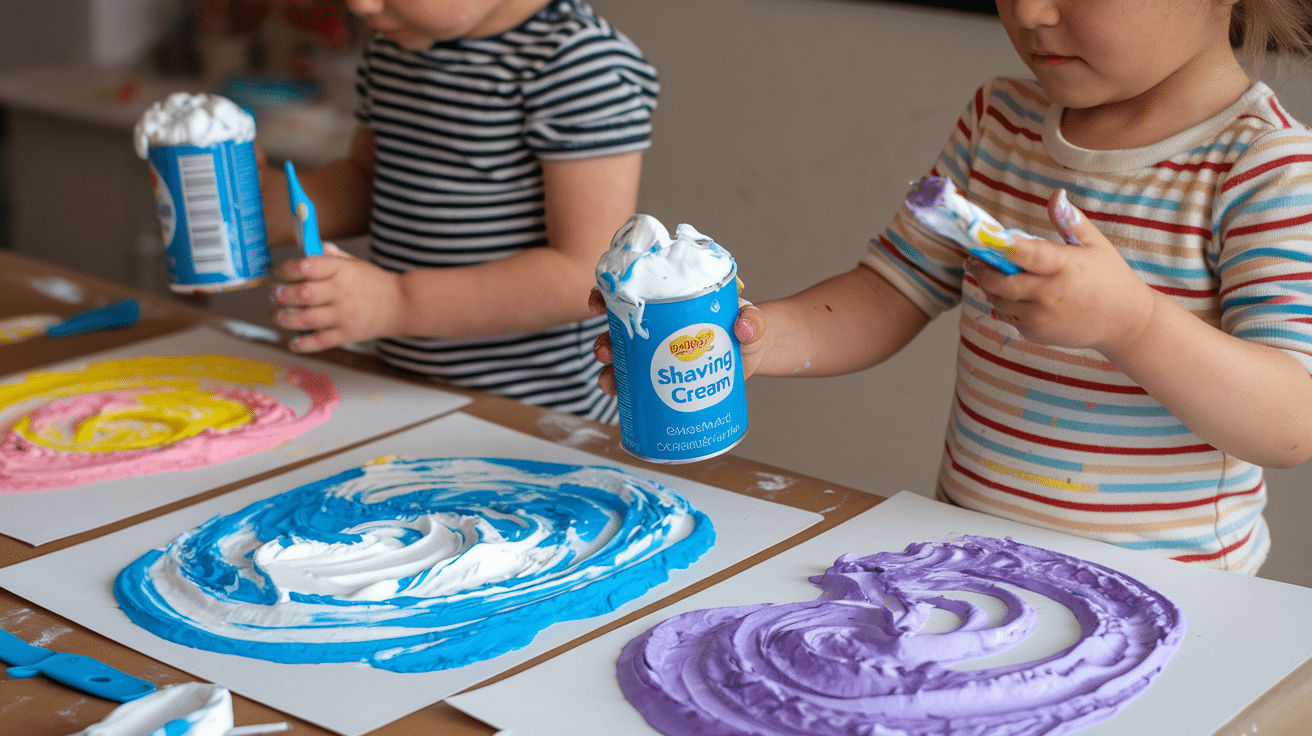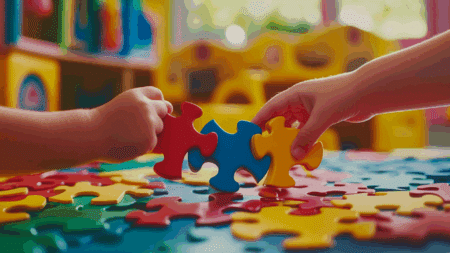Kids get bored fast. Parents know the struggle of finding activities that keep children engaged while helping them learn.
The constant search for new, budget-friendly play options can leave moms and dads feeling tired and out of ideas.
Shaving cream sensory play offers a simple solution. This versatile material changes ordinary afternoons into compelling play sessions that children actually enjoy.
With just a can of shaving cream, you can create dozens of hands-on activities that boost creativity, improve fine motor skills, and provide the sensory input kids need for development.
The best part? These activities work for toddlers through elementary-aged children, making them perfect for mixed-age siblings or playdates.
What is Shaving Cream Sensory Play?
Shaving cream sensory play is a hands-on activity that uses the soft, fluffy feel of shaving cream to engage children’s senses.
When kids touch, squish, and spread the cream, they get direct input to their touch sensors.
The bright white base can be mixed with colors to add visual appeal. Whipped chickpea water (aquafaba) is a safe substitute for families with very young children.
You can set up these activities in plastic bins for easy cleanup, on windows where kids can draw and wipe, or outside where mess isn’t a concern.
This flexible play option fits many settings and age groups.
Why Shaving Cream Sensory Play Is Worth It

Shaving cream play offers multiple growth benefits for children beyond just fun. When kids play with this material, they develop in several key areas:
Sensory exploration: Children who feel different textures become less sensitive to touch and more comfortable with messy substances.
Fine motor skills: Swirling, patting, and moving the cream work small finger muscles needed for writing and daily tasks.
Cognitive development: Kids learn cause-effect relationships and build memory as they mix colors or watch how the cream changes.
Language and social skills: The play setup creates natural opportunities for talking, sharing, and making up stories together.
Emotional regulation: The smooth texture has a calming effect, helping upset children reset their feelings.
Early learning support: Children practice drawing letters, shapes, and numbers in a low-pressure way.
Fun Shaving Cream Sensory Play Activities for Kids

Now let’s jump into the fun part! This collection offers something for every child’s interests and developmental stage.
Parents can pick activities based on what they have at home or what skills their kids need to practice.
The beauty of these ideas is their simplicity. Most need only shaving cream and one or two extra items. Try one today and see how quickly children become engaged in hands-on learning.
1. Shaving Cream Treasure Hunt
Hide small toys or household items in a bin filled with shaving cream and let kids dig through to find them.
This activity helps with tactile exploration, curiosity, and memory. For added fun, let kids guess each object before pulling it out, or describe it while it’s still hidden.
- Skills Developed: Sensory exploration, cognitive development, language skills
- Age Group: 2–6 years
2. Frozen Shaving Foam Dig
Prep this one a day ahead! Freeze colored water or small toys in ice cube trays, then bury the frozen cubes in a bin of shaving cream.
Kids will love feeling the contrast of cold ice and soft foam while watching colors swirl as the cubes melt.
- Skills Developed: Sensory contrast awareness, scientific thinking, curiosity
- Age Group: 3–7 years
3. Sensory Bag Letter Experience
Fill a sealable plastic bag with shaving cream, a few drops of food coloring, and letter tiles or magnetic letters.
Let kids squish the bag to uncover hidden letters and name them as they go. It’s mess-free and great for letter recognition and sensory input.
- Skills Developed: Letter recognition, fine motor skills, and early literacy
- Age Group: 2–5 years
4. Rainbow Shaving Cream Bin
Layer colorful blobs of shaving cream in a bin using food coloring or liquid watercolors. Let kids swirl the colors together with their fingers, toy tools, or brushes.
They’ll love the visual surprise as colors blend, creating their own rainbow masterpiece.
- Skills Developed: Color mixing, fine motor control, visual creativity
- Age Group: 2–6 years
5. Hidden Object Guessing Game
Hide various objects under a thick layer of shaving cream and have kids reach in to feel and guess what each item is. It’s a fantastic way to build sensory memory and descriptive language as they feel textures and shapes.
- Skills Developed: Tactile processing, language development, memory skills
- Age Group: 3–7 years
6. Shaving Cream & Marbles Search
Drop marbles into a tray filled with shaving cream and let kids dig through to find them using just their fingers or tongs. It strengthens hand muscles and coordination while offering a fun, squishy challenge.
- Skills Developed: Fine motor strength, hand-eye coordination, sensory input
- Age Group: 2–5 years
7. Shaving Cream Soup Kitchen
Set up a pretend soup-making station with bowls of shaving cream, ladles, spoons, and mix-ins like buttons or pom-poms. Kids can create “recipes,” serve up pretend meals, and feel textures while role-playing.
- Skills Developed: Imaginative play, social interaction, emotional expression
- Age Group: 3–6 years
8. Window Shaving Cream Painting
Spread shaving cream on a large window or sliding glass door and let kids finger-paint to their heart’s content.
Add food coloring or washable paint to make it even more vibrant. Cleanup is easy with a squeegee and water.
- Skills Developed: Gross motor movements, creative expression, sensory calming
- Age Group: 2–6 years
9. Puffy Paint Picture Creations
Mix shaving cream with glue and flour to make thick, puffy paint. Kids can paint with brushes or fingers and watch as their artwork dries into a raised, squishy texture. It’s a hands-on art sensory experience.
- Skills Developed: Art exploration, sensory stimulation, hand strength
- Age Group: 3–7 years
10. Marble Print Art with Shaving Cream
Let kids swirl drops of food coloring into a tray of shaving cream, then press a piece of paper on top to create marbled prints. Peel it off, scrape the foam, and admire the colorful designs. It’s simple, stunning art.
- Skills Developed: Color theory, process art, fine motor engagement
- Age Group: 4–8 years
11. Mirror Tape Resist Art
Tape off simple shapes or letters on a mirror, then let kids cover the whole surface with colored shaving cream. Once the cream is removed, the tape reveals a clean design underneath. It’s a magical reveal for little artists.
- Skills Developed: Visual-motor coordination, letter recognition, creativity
- Age Group: 3–6 years
12. Shaving Cream Mosaic Tray
Spread shaving cream on a tray and offer small items like beads, cut straws, and buttons. Kids press pieces into the foam to create their mosaics, which can be easily reset by smoothing out the surface.
- Skills Developed: Fine motor accuracy, spatial reasoning, design thinking
- Age Group: 2–5 years
13. Puffy Planet Painting
Craft a solar system using shaving cream-based puffy paint. Kids mix colors and paint textured planets on paper, learning about space while engaging in sensory-rich, creative expression.
- Skills Developed: Science concepts, sensory exploration, artistic expression
- Age Group: 4–8 years
14. Rainbow Marble Art
Add a few drops of different food colorings to shaving cream and let kids swirl the colors using a stick or brush. Press a piece of paper onto the surface and peel it back for a beautiful marbled rainbow effect.
- Skills Developed: Creativity, fine motor coordination, color blending
- Age Group: 3–7 years
15. Writing Practice in Shaving Cream
Spread shaving cream on a tray or table and let kids practice writing letters, numbers, or even words using their fingers. It’s a playful way to build handwriting confidence.
- Skills Developed: Early writing skills, fine motor practice, sensory engagement
- Age Group: 3–6 years
16. Tracing Letters or Shapes
Using flashcards or prompts, kids can trace shapes or letters in a layer of shaving cream. This activity encourages early literacy and gives tactile feedback that helps reinforce learning.
- Skills Developed: Letter formation, fine motor skills, and early literacy
- Age Group: 2–5 years
17. Alphabet Ice Cube Search
Freeze plastic alphabet letters in ice cubes and place them in a bin of shaving cream. Kids dig through the foam, find letters, and match or name them, practicing early phonics while engaging multiple senses.
- Skills Developed: Letter recognition, phonics awareness, sensory exploration
- Age Group: 4–7 years
18. Subtraction Smash Game
Place numbers or small toys in shaving cream, then call out subtraction problems. Kids smash the correct number of items each time to solve the problem, learning math in a hands-on, fun way.
- Skills Developed: Early math skills, number sense, gross motor coordination
- Age Group: 5–8 years
19. Shaving Cream STEM Block Towers
Use shaving cream like glue to stack and build with foam blocks or cups. It’s a great introduction to basic engineering and physics as kids learn about balance, height, and structure.
- Skills Developed: STEM thinking, spatial reasoning, problem-solving
- Age Group: 4–8 years
20. Rain Cloud in a Jar Science Demo
Fill a clear jar with water and top it with a shaving cream “cloud.” Let kids drop food coloring onto the foam and watch it fall through like rain. A visual way to learn about weather systems.
- Skills Developed: Scientific observation, cause-effect understanding, and patience
- Age Group: 3–7 years
21. Find the Letter with Scrabble Tiles
Drop Scrabble tiles or alphabet magnets into a bin of shaving cream. Kids dig, find, and name the letters they find, perfect for sensory learners developing alphabet awareness.
- Skills Developed: Alphabet recognition, sensory engagement, language skills
- Age Group: 3–6 years
22. Shaving Cream Bakery (pies, cupcakes)
Give kids baking cups, pie tins, and pretend toppings, then let them create frothy cupcakes and pies using colored shaving cream. It encourages imaginative play and fine motor practice.
- Skills Developed: Imaginative play, fine motor development, role-playing
- Age Group: 3–6 years
23. Dragon World Small Bin
Create a fantasy small world with dragon figurines, rocks, and colored shaving cream as lava or clouds. This sensory bin invites storytelling, creativity, and role-playing in a magical setting.
- Skills Developed: Storytelling, creativity, social-emotional development
- Age Group: 3–7 years
24. Shaving Cream Cake Decorating
Set up trays with colored shaving cream and cake-like items (paper plates, sponges, or stacked cups). Kids use tools like spatulas and spoons to “frost” and decorate pretend cakes with buttons, beads, or pom-poms.
- Skills Developed: Fine motor skills, creativity, imaginative play
- Age Group: 3–6 years
25. Lemon Meringue Pie Station
Offer paper plates, yellow pom-poms or paper circles (lemons), and a bowl of fluffy white shaving cream. Kids build pretend lemon meringue pies, working their imaginations while practicing scooping and spreading.
- Skills Developed: Pretend play, hand-eye coordination, sensory exploration
- Age Group: 3–6 years
26. Dinosaur Dig in Sandy Foam
Mix sand with shaving cream for a gritty texture, then bury small dinosaur toys inside. Kids dig, find, and name the dinosaurs, just like little paleontologists on an excavation experience.
- Skills Developed: Sensory exploration, vocabulary building, and scientific curiosity
- Age Group: 4–7 years
27. Shaving Cream Car Wash Setup
Create a mini car wash with toy vehicles and tubs of shaving cream and water. Kids drive cars through the “soap,” scrub them clean, and rinse them off. It is perfect for outdoor play and pretend scenes.
- Skills Developed: Imaginative play, fine motor control, sequencing
- Age Group: 2–6 years
28. Foam Construction Site Play
Fill a bin with shaving cream and construction vehicles like diggers and dump trucks. Add rocks, blocks, or sticks for an immersive sensory construction zone. This is great for scooping, pushing, and imaginative role-play.
- Skills Developed: Role-playing, gross motor skills, sensory integration
- Age Group: 3–7 years
29. Rainbow Cloud Dough
Combine shaving cream with cornstarch and food coloring to create soft, fluffy cloud dough in different hues. Kids can knead, mold, and sculpt the colorful dough for a hands-on sensory treat.
- Skills Developed: Tactile awareness, creativity, hand strength
- Age Group: 3–7 years
30. Foam Dough Sensory Play
Mix equal parts shaving cream and cornstarch to form moldable foam dough. Kids squeeze, press, and roll it into shapes, strengthening hand muscles while exploring a new texture.
- Skills Developed: Fine motor development, sensory exploration, creativity
- Age Group: 2–6 years
31. Shaving Cream Slime Mixing
Add shaving cream to basic slime recipes to create fluffy, airy slime. Let kids stretch and squish it for an ultra-sensory experience they’ll love coming back to again and again.
- Skills Developed: Sensory regulation, hand coordination, focus
- Age Group: 4–8 years
32. Homemade Puffy Paint Dough
Mix shaving cream with flour and glue to form puffy dough. Add food coloring and let kids sculpt or paint with it—it dries overnight into raised, textured creations.
- Skills Developed: Artistic expression, texture exploration, patience
- Age Group: 3–7 years
33. Aquafaba Foam for Toddlers
For toddlers who may put things in their mouths, use aquafaba (whipped chickpea water) as a safe, edible shaving cream alternative. Let them squeeze, swirl, and pat the foam worry-free.
- Skills Developed: Safe sensory play, touch sensitivity, exploratory learning
- Age Group: 1–3 years
34. Shaving Cream Snow Play
Whip up “snow” by combining shaving cream with baking soda or let kids play with plain white foam in a winter-themed bin. Add toy penguins, snowflakes, or scoops for seasonal sensory fun.
- Skills Developed: Seasonal awareness, imaginative play, sensory engagement
- Age Group: 2–6 years
35. Shaving Cream Twister
Play a foamy version of Twister by spraying colored shaving cream on each circle of a Twister mat. Kids will giggle and stretch as they balance on slippery, colorful spots.
- Skills Developed: Gross motor skills, balance, body awareness
- Age Group: 4–8 years
36. Giant Rainbow Foam Wall
Spray thick bands of colored shaving cream onto a fence or shower curtain liner hung outside. Let kids use hands or brushes to mix, spread, and create rainbow murals.
- Skills Developed: Creative expression, large motor coordination, visual arts
- Age Group: 3–7 years
37. Shaving Cream Battle Game
Take the fun outdoors for a friendly shaving cream fight! Kids can wear old clothes or swimsuits and squirt each other with foam, then rinse off with a hose for easy cleanup.
- Skills Developed: Physical play, social bonding, stress relief
- Age Group: 5–10 years
How to Play Without Making a Huge Mess

Shaving cream play doesn’t have to mean hours of cleanup. With a few smart steps, you can keep the fun high and the mess low:
Spread a plastic tablecloth under play areas to catch spills and make cleanup as simple as folding it up.
Move the fun outdoors when weather permits, patios and grass areas let you hose away leftovers.
Stack bath towels and baby wipes within reach for quick hand and surface cleaning.
Create sealed sensory bags by putting shaving cream and colors in ziplock bags for touch without the mess.
For children who might taste materials, switch to food-safe options like whipped cream or chickpea water foam (aquafaba), which won’t harm if they go in little mouths.
Conclusion
Shaving cream sensory play brings big benefits with small effort. The key is starting simple, one can of cream opens up dozens of play options.
Remember that what matters most is the time spent with your child, not how fancy the setup looks. You know your child best, so feel free to change any idea to fit their age, skills, or interests.
Just keep an eye on little ones who might try tasting the cream, and you’re all set for hours of hands-on learning through play.
Have you tried shaving cream play with your kids? I’d love to hear which activity was their favorite! Share your experience in the comments below or tell us about your own creative twist on these ideas.
And if you found this helpful, please pass it along to other parents looking for easy, budget-friendly ways to keep their kids engaged.




